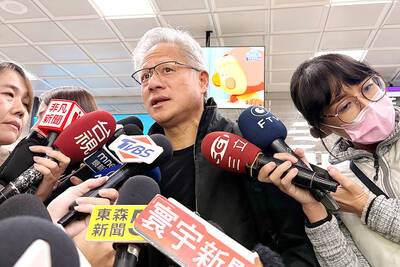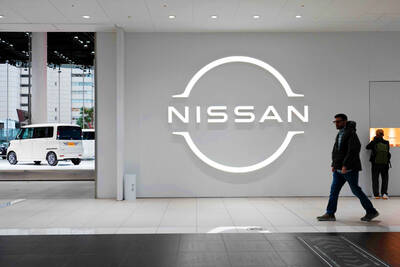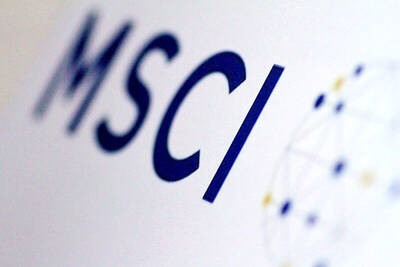Qualcomm Inc’s interest in pursuing an acquisition of Intel Corp has cooled, people familiar with the matter said, upending what would have likely been one of the largest technology deals of all time.
The complexities associated with acquiring all of Intel has made a deal less attractive to Qualcomm, said some of the people, asking not to be identified discussing confidential matters.
It is always possible Qualcomm looks at pieces of Intel instead or rekindles its interest later, they added.

Photo: Reuters
Representatives for Qualcomm and Intel declined to comment.
Qualcomm made a preliminary approach to Intel on a possible takeover, Bloomberg News and other media firms reported in September.
It came just weeks after Intel released a bruising earnings report in which it delivered a disappointing revenue forecast and outlined a 15 percent reduction in headcount in an effort to “resize and refocus.”
However, the transaction faced numerous financial, regulatory and operational hurdles, including the assumption of Intel’s more than US$50 billion in debt. It likely would have drawn a lengthy and arduous antitrust review, including in China, which is a key market for both companies.
Qualcomm would have had to handle Intel’s money-losing semiconductor manufacturing unit, a business where it has no experience.
Qualcomm has been looking ahead to new markets — including PCs, networking and automotive chips — to generate an additional US$22 billion in annual revenue by fiscal 2029.
The San Diego-headquartered firm’s chief executive officer, Cristiano Amon, told Bloomberg Television in an interview last week that, “right now, at this time, we have not identified any large acquisition that is necessary for us to execute on this US$22 billion.”
Intel, which until relatively recently was among the largest chipmakers by value, is in the middle of trying to reinvent itself.
Rivals such as Nvidia Corp have been pulling away in the race to supply chips that can cater to the demand for artificial intelligence.
The Santa Clara, California-based company has a market value of about US$107 billion. That is despite its stock having declined about 51 percent so far this year.
Intel chief executive officer Pat Gelsinger said in an interview earlier this month that he intends to keep the company together and has the support of the board for his plan, adding that he has a “lot of energy and passion” to bring to that effort.
“Obviously, there’s a lot of attention on Intel, which just reinforces what a central role it plays in the technology industry,” Gelsinger said during the interview. “We believe distinct, but better together, is the strategy.”
Separately, US President Joe Biden's administration said yesterday that it has finalized a deal to give Intel nearly US$7.9 billion in federal grants, the largest direct subsidy from a program to boost domestic semiconductor manufacturing.
The agreement for the struggling chipmaker, smaller than an earlier proposed award, means that Intel can begin receiving funds as it hits negotiated benchmarks on projects in four US states. The company will qualify for at least US$1 billion this year, a senior administration official said, based on milestones it has already reached.
Specifically, Intel will get money for projects in Arizona, Oregon and New Mexico, according to a person familiar with the matter. The company’s greenfield site in Ohio, which has been delayed by several years, is not yet eligible for any federal support, the person said, though it has already received US$2 billion from the state.
Intel’s award will result in “American-designed chips being manufactured and packaged by American workers, in the United States, by an American company, for the first time in a very long time,” said US Secretary of Commerce Gina Raimondo, whose agency is in charge of implementing the 2022 CHIPS and Science Act. The landmark bipartisan law set aside US$39 billion in grants, US$75 billion in loans and loan guarantees, and 25 percent tax credits to revitalize American chipmaking.

PERSISTENT RUMORS: Nvidia’s CEO said the firm is not in talks to sell AI chips to China, but he would welcome a change in US policy barring the activity Nvidia Corp CEO Jensen Huang (黃仁勳) said his company is not in discussions to sell its Blackwell artificial intelligence (AI) chips to Chinese firms, waving off speculation it is trying to engineer a return to the world’s largest semiconductor market. Huang, who arrived in Taiwan yesterday ahead of meetings with longtime partner Taiwan Semiconductor Manufacturing Co (TSMC, 台積電), took the opportunity to clarify recent comments about the US-China AI race. The Nvidia head caused a stir in an interview this week with the Financial Times, in which he was quoted as saying “China will win” the AI race. Huang yesterday said

Nissan Motor Co has agreed to sell its global headquarters in Yokohama for ¥97 billion (US$630 million) to a group sponsored by Taiwanese autoparts maker Minth Group (敏實集團), as the struggling automaker seeks to shore up its financial position. The acquisition is led by a special purchase company managed by KJR Management Ltd, a Japanese real-estate unit of private equity giant KKR & Co, people familiar with the matter said. KJR said it would act as asset manager together with Mizuho Real Estate Management Co. Nissan is undergoing a broad cost-cutting campaign by eliminating jobs and shuttering plants as it grapples

The Chinese government has issued guidance requiring new data center projects that have received any state funds to only use domestically made artificial intelligence (AI) chips, two sources familiar with the matter told Reuters. In recent weeks, Chinese regulatory authorities have ordered such data centers that are less than 30 percent complete to remove all installed foreign chips, or cancel plans to purchase them, while projects in a more advanced stage would be decided on a case-by-case basis, the sources said. The move could represent one of China’s most aggressive steps yet to eliminate foreign technology from its critical infrastructure amid a

MORE WEIGHT: The national weighting was raised in one index while holding steady in two others, while several companies rose or fell in prominence MSCI Inc, a global index provider, has raised Taiwan’s weighting in one of its major indices and left the country’s weighting unchanged in two other indices after a regular index review. In a statement released on Thursday, MSCI said it has upgraded Taiwan’s weighting in the MSCI All-Country World Index by 0.02 percentage points to 2.25 percent, while maintaining the weighting in the MSCI Emerging Markets Index, the most closely watched by foreign institutional investors, at 20.46 percent. Additionally, the index provider has left Taiwan’s weighting in the MSCI All-Country Asia ex-Japan Index unchanged at 23.15 percent. The latest index adjustments are to